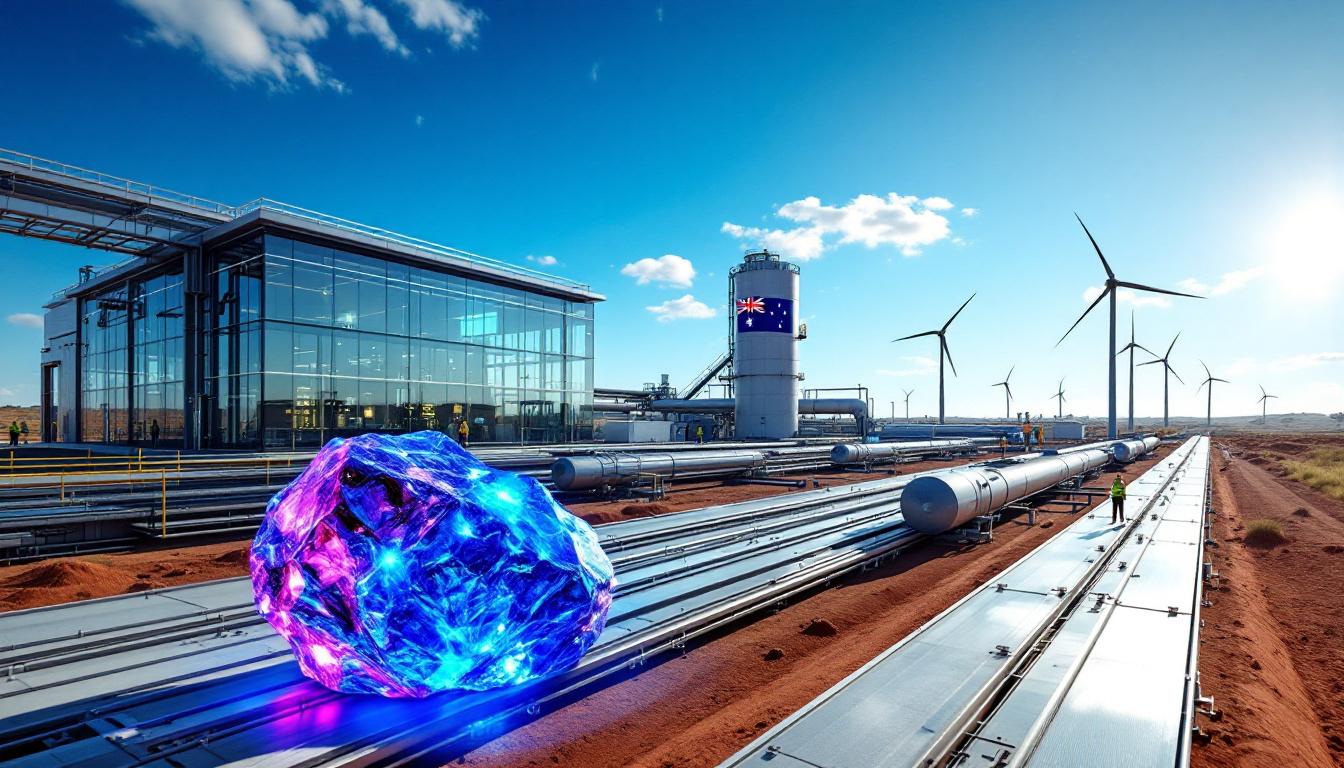US and China Rare Earth Negotiations: Strategic Implications for Global Supply Chains
In a landscape of complex geopolitical tensions, the ongoing negotiations between the United States and China over rare earth magnets represent a critical juncture for global technology supply chains. Recent developments point to potential progress, though significant challenges remain in establishing a stable trade relationship for these essential materials.
What Are the Current Developments in US-China Rare Earth Talks?
Recent Progress in Stockholm Negotiations
US Trade Representative Jamieson Greer has characterized the talks as "about halfway there" following the conclusion of the Stockholm discussions in late July 2025. During an interview on CBS's Face the Nation, Greer stated, "We're focused on making sure that magnets from China to the United States and the adjacent supply chain can flow as freely as it did before the control."
Beijing and Washington have agreed to extend their existing tariff truce after what officials described as productive negotiations. This extension provides breathing room for continued dialogue, though the current agreement expires on August 12, 2025, with President Trump set to make the final determination on whether to maintain the arrangement.
The US delegation, led by Greer and Treasury Secretary Scott Bessent, has reportedly secured unspecified commitments regarding rare earth supply chains, though details remain limited about the exact nature of these agreements.
Timeline of Recent Rare Earth Tensions
The current situation stems from China's implementation of export controls on rare earth magnets approximately four months ago, around early April 2025. These controls were explicitly positioned as retaliation against US‑China trade strategies, creating immediate disruption in global supply chains.
In recent weeks, Beijing has agreed to accelerate shipments after Washington suspended high tariffs on Chinese exports. This compromise has helped stabilize the immediate supply situation, though volumes remain below pre-restriction levels.
Disclaimer: The following analysis represents an assessment based on currently available information. Geopolitical situations remain fluid, and conditions may change rapidly as negotiations continue.
How Have Rare Earth Magnet Flows Been Affected?
Supply Chain Impact Analysis
Recent customs data reveals the tangible impact of the diplomatic tensions on actual trade flows. June 2025 saw 353 tons of rare earth magnets flow from China to the US, representing a significant increase from just 46 tons in May—a remarkable 668% month-over-month increase.
Despite this substantial improvement, total shipments remain considerably lower than pre-control levels established before Beijing launched export controls in early April 2025. This ongoing shortfall continues to create challenges across multiple industries.
Rare earth magnets are critical components in numerous high-value applications including:
- Defense systems including guidance systems and radar
- Electric vehicle motors and batteries
- Wind turbine generators
- Smartphones and consumer electronics
- Medical imaging equipment
- Industrial automation systems
- Home appliances and HVAC systems
The disruption affects not just finished magnets but the entire "adjacent supply chain" mentioned by Trade Representative Greer—including processed rare earth oxides, metals, and alloys at various stages of production.
Strategic Importance of Rare Earth Supply
The current tensions highlight the strategic vulnerability created by concentrated supply chains. China's dominant position in rare earth processing and magnet production has evolved over decades through deliberate industrial policy, creating a situation where approximately 85% of global rare earth reserves analysis shows processing occurs within its borders.
For the United States, this dependency represents both an economic and national security concern. While domestic production exists primarily through MP Materials at the Mountain Pass mine in California, processing capacity remains limited compared to Chinese capabilities.
| Rare Earth Element | Primary Applications | Supply Chain Vulnerability |
|---|---|---|
| Neodymium | Permanent magnets, lasers | High – China dominates processing |
| Dysprosium | High-temperature magnets | Very high – Limited global sources |
| Samarium | Specialty magnets, cancer treatments | Moderate – Multiple processing options |
| Terbium | Phosphors, sonar systems | High – Concentrated production |
| Praseodymium | Magnets, glass colorant | Moderate – Growing alternative sources |
Diversification efforts are underway in the US and allied nations, but establishing competitive processing capacity requires significant investment and typically 3-5 years for new facilities to reach full operational status.
What Are the Broader Implications for US-China Relations?
Current State of Bilateral Trade Relations
The rare earth negotiations represent just one facet of the complex US-China economic relationship. The completion of a third round of trade talks in Stockholm at the end of July 2025 has helped stabilize relations between the world's two largest economies, though many frictions remain unresolved.
According to Greer, the US trade team hopes to complete the magnets discussion to enable "a further discussion of the US-China relationship," indicating the issue is being treated as a foundational element in rebuilding broader economic ties.
The Trump administration has recently pledged to drop export restrictions on less-advanced AI chip technology to China, a move that has sparked speculation about the potential for a broader trade agreement. This shift in policy suggests a willingness to find compromise in certain technology sectors while maintaining restrictions in others.
Technology and Security Concerns
Technology transfer and security issues continue to complicate the relationship. In a revealing development, Chinese authorities recently summoned Nvidia Corporation regarding alleged security vulnerabilities related to its H20 chips.
China's Cyberspace Administration specifically cited comments by US lawmakers about installing tracking capabilities into advanced chips exported to other countries. This incident highlights the deep suspicion that continues to characterize technological exchanges between the nations.
The tensions extend beyond rare earths to encompass:
- Advanced semiconductor restrictions
- Data security and cross-border information flows
- Intellectual property protections
- Investment screening mechanisms
- Critical infrastructure security
As Trade Representative Greer works toward resolving the rare earth magnet issue, these parallel concerns continue to shape the broader negotiating environment.
What Are the Next Steps in Rare Earth Negotiations?
Remaining Challenges and Milestones
While progress has been made, significant technical issues remain under discussion with President Trump, according to Greer's statements. The August 12 deadline for the tariff truce extension looms large over these conversations, creating both urgency and leverage for negotiators.
Complete resolution would require addressing several complex dimensions:
- Export control mechanisms – Determining what level of monitoring and restriction remains acceptable to both sides
- Supply chain transparency – Establishing visibility into production and shipment volumes
- Verification procedures – Creating mutually acceptable methods to confirm compliance
- Long-term stability guarantees – Moving beyond temporary truces to durable arrangements
These technical details often prove more challenging than the high-level political agreements, requiring detailed work by specialists from both countries.
Global Supply Chain Implications
The rare earth supply disruptions extend far beyond bilateral US-China relations, affecting industries worldwide. Manufacturing companies globally are reassessing supply chain resilience in light of recent volatility.
Alternative rare earth sources are being developed in Australia, Canada, and several African nations, but these projects face significant challenges:
"Establishing new rare earth processing capacity isn't simply about mining—it requires specialized knowledge, substantial capital investment, and complex chemical processing facilities. Even with accelerated timelines, new operations typically require 3-5 years to reach commercial scale."
Pricing volatility will likely continue until a stable agreement is reached, with downstream effects for manufacturers of everything from wind turbines to defense systems. Companies are increasingly building supply buffers and investigating material substitution where technically feasible.
How Are Other Countries Responding to Rare Earth Supply Challenges?
International Diversification Efforts
The US-China tensions have accelerated global efforts to diversify rare earth supply chains. Countries worldwide are pursuing multi-faceted strategies:
- Australia has positioned itself as a key alternative supplier, with Lynas Rare Earths expanding production and establishing a critical minerals reserve
- Canada is developing deposits in Saskatchewan and the Northwest Territories with government support
- European Union has launched the European Raw Materials Alliance (ERMA) to secure sustainable supply chains
- Japan continues strategic stockpiling while investing in recycling technologies
- India is working to revitalize domestic rare earth production through public-private partnerships
These efforts collectively aim to reduce China's market dominance, though progress remains gradual given the technical complexity and capital requirements of establishing competitive operations.
Regulatory and Policy Approaches
Governments are implementing diverse policy tools to address rare earth vulnerabilities:
- Tax incentives for domestic rare earth mining, processing, and magnet manufacturing
- Strategic stockpiles being established or expanded in several countries
- Research funding for alternative materials and improved recycling technologies
- Trade agreements increasingly incorporating critical mineral provisions
- Environmental regulations being balanced against supply security concerns
The challenge remains balancing immediate supply needs with long-term strategic goals. While emergency measures may address short-term shortages, sustainable solutions require consistent policy support over multiple years.
What Are the Economic Implications of Rare Earth Trade Disruptions?
Market Impact Assessment
The recent supply chain turbulence has created measurable economic effects across multiple sectors:
- Price volatility in rare earth markets, with spot prices for certain elements increasing 30-50% during peak disruption
- Manufacturing delays affecting technology and defense contractors reliant on steady magnet supplies
- Increased costs for products containing rare earth components, particularly in clean energy and electronics
- Investment surge in rare earth mining and processing ventures, with several companies reporting accelerated funding rounds
- Supply chain reconfiguration costs as manufacturers implement redundancy and alternative sourcing strategies
These effects ripple through complex global supply networks, often with magnified impacts at each step in the value chain.
Long-term Market Outlook
Looking beyond the immediate negotiations, several trends are shaping the future rare earth landscape:
- Demand growth will continue as electric vehicles, renewable energy, and advanced electronics expand globally
- Supply diversification will progress gradually, reducing but not eliminating China's market position
- Technological innovation may reduce dependence on specific elements through substitution and efficiency improvements
- Recycling economics will improve as prices rise and collection systems mature
- Strategic considerations will ensure continued government involvement in market development
Industry analysts suggest a transition period of 5-7 years before a significantly more diversified global supply chain emerges, assuming continued policy support and investment.
FAQ: US-China Rare Earth Relations
What are rare earth magnets and why are they important?
Rare earth magnets are powerful permanent magnets made with rare earth elements like neodymium, samarium, and dysprosium. They're crucial for miniaturization of electronics, efficient electric motors, wind turbines, and defense applications due to their exceptional magnetic strength-to-weight ratio. These magnets can maintain magnetic fields up to 20 times stronger than conventional ferrite magnets, enabling smaller, lighter, and more efficient devices across numerous industries.
Why does China dominate the rare earth market?
China's dominance stems from decades of strategic investment, abundant resources, willingness to accept environmental impacts, technical expertise development, and integrated supply chains combining mining, processing, and manufacturing capabilities. Beginning in the 1980s, China recognized the strategic importance of rare earths and implemented policies to develop comprehensive capabilities while many Western producers closed operations due to environmental concerns and economic pressures.
What alternatives exist to Chinese rare earth supplies?
Alternatives include developing mines in countries like Australia, Canada, and the United States, investing in recycling technologies, researching substitute materials, and creating strategic reserves to buffer against supply disruptions. Mountain Pass mine in California (operated by MP Materials) represents the largest non-Chinese source, though processing capabilities remain limited compared to China's comprehensive facilities.
How do rare earth trade issues affect consumers?
Consumers may face higher prices and potential availability issues for products containing rare earth components, including smartphones, computers, electric vehicles, and certain medical devices if supply chains remain disrupted. While raw material costs typically represent a small percentage of final product prices, sustained disruptions can create manufacturing bottlenecks leading to delayed product launches and limited availability of certain models or configurations.
What steps is the US taking to secure rare earth supplies?
The US is pursuing diplomatic negotiations with China, supporting domestic production through tax incentives and funding, developing international partnerships with allied nations, investing in recycling technologies, and researching alternative materials. The Department of Defense has also implemented programs to support domestic production capacity for rare earth magnets considered essential for military applications, while the Department of Energy funds research into mineral energy security and green transition materials.
Further Exploration:
Readers interested in learning more about US-China rare earth negotiations can also explore related educational content from MINING.com, which regularly covers developments in critical minerals markets and international trade relations.
Interested in Getting Early Insights into Major Mineral Discoveries?
Stay ahead of the market with Discovery Alert's proprietary Discovery IQ model, which delivers real-time notifications when significant mineral discoveries are announced on the ASX, turning complex data into actionable investment opportunities. Visit our discoveries page to see how historic mineral discoveries have generated substantial returns for early investors.




